Last week 5 species of geese surrounded my office in every direction – one of my favorite times of the year. I savor the sights and sounds, and make the most of the opportunity to get into position to photograph the birds in a number of different situations: In flight, swimming, feeding; in family groups, small flocks, and huge flocks. Lighting is pretty good most of the day now at this norther latitude just south of Canada, as long as the sun is shining and it’s behind you pointing your shadow at the geese.
This week, I tried to emphasize taking photos of each of the 5 species of geese in the area – to get representative photos of each plumage, such as adults vs immatures. In the case of Snow Geese it gets a bit more complicated, which is a good thing; it includes photographing adults and young birds of each color morph – white and blue – as well as representative hybrids, created when a blue adult pairs with a white adult. The resulting generation of adults tend to resemble a blue morph with varied amounts of white on the belly, and sometimes extending up the neck or across the entire underside. It is very interesting to photograph the differently colored Snow Geese nonetheless.
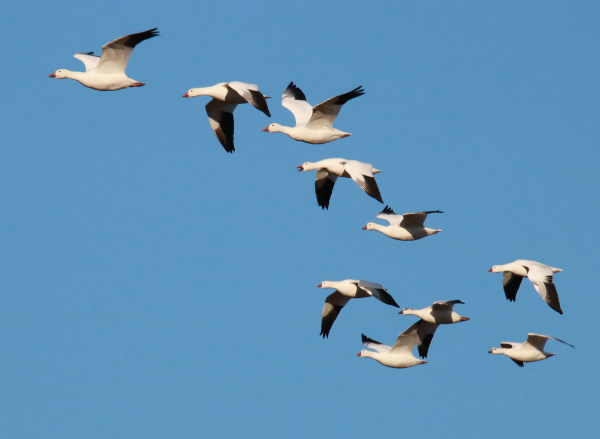
Then, to keep your eyesight sharp, there is a percentage of the huge Snow Goose flocks that are actually Ross’s Geese. It’s often hard to differentiate between the Ross’s Geese from Snows in the field, especially when they are flying, due to Ross’s similarity to white morph Snow Geese. However, Ross’s Geese are pretty easy to pick out of photographs you take. These white geese with black flight feathers stand out due to their much smaller size – they are half the size of a Snow Goose, and the difference is more obvious when you compare the sizes of the birds’ head and bill. Ross’s Geese have a comparatively smaller head and bill, which you can see in the accompanying photographs – but when they’re flying it’s surprisingly hard to distinguish the 2 species. When they are swimming, it’s easier distinguish the 2 in the field.
There is a similar size differential between Arctic-nesting Cackling Geese and the larger Canada Geese. Generally, Cacklers tend to be about half the size of Canada Geese too, and in flight photos the difference is most obvious when you check the length of the neck, and the size of the head and bill.
White-fronted Geese can resemble Canada and Cackling Geese from a distance, but the closer you get the easier it is to distinguish White-fronts from the 2 black-necked species. Within family groups and larger flocks, adult and first year White-fronted Geese can be differentiated fairly easily because young White-fronts lack white feathering on their face and black stripes on their belly, both of which distinguish adults. The thing that really separates White-fronted Geese from other species is their high-pitched calls; once you’ve heard it, you’ll never forget it, and it’s a favorite sound for me.
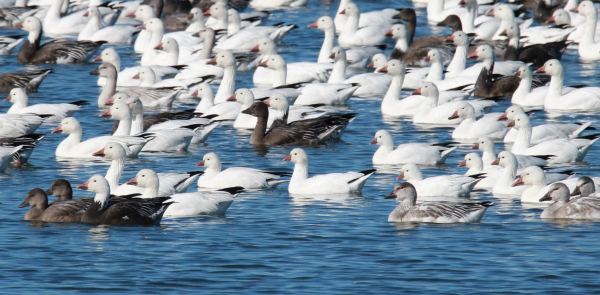
Pass Photography
With geese in every direction, when the sun is right I tend to check flocks a couple miles to the north, then I spy on flocks up to 2 miles south, then a mile east – if I get that far. Usually, I am short-stopped by a good photo opportunity. Sometimes I enjoy photographing flocks as they settle into an after-feeding rest period on an area lake; sometimes I photograph on the edge of a big feeding flock. But the option that has paid off the most photo dividends has been to position myself with the sun at my back between a big water loafing area and a feeding site to photograph flocks as they fly from one location to the other. Some geese invariably fly low and within range of my zoom lens.
It’s obviously best to have the geese flying toward you or broadside rather than flying away, but it’s worth mentioning I think. I find myself zeroing in on family groups of 3 to 5 geese, usually a pair with young of the year. Of course, I also take advantage of larger flocks of geese, although I tend to focus on a part of the flock, usually the leading birds and however many others fit into the photo frame.
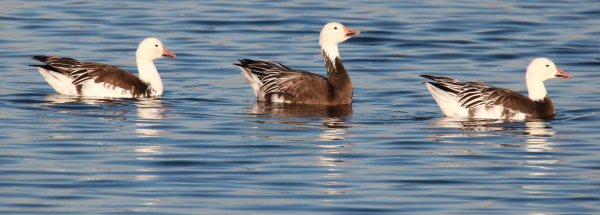
I usually photograph from inside my vehicle, which geese accept much more readily than a person standing in the open. Geese are very keen-eyed, and even if you try to hide, any level of motion is easily detected and avoided. While in my mobile blind, I usually brace my camera lens on the open window frame; and of course, my vehicle is turned off when photographing to eliminate engine shake. I also hold my breath when pressing the camera’s shutter button to reduce any body shake.
Shutter speed and aperture are always a balancing act, but this week I’ve been using an f8 aperture, which usually provides a fast shutter speed of 1/1600 or faster. When photographing flying geese I tend to take 2 photos at a time – click-click – 2 or more that is. While photographing flying geese, the action is fast but I try to watch for shadows, try to anticipate when the wings will be up to avoid shadows created by the wings, and I watch for how birds line up so they don’t overlap in resulting photos.
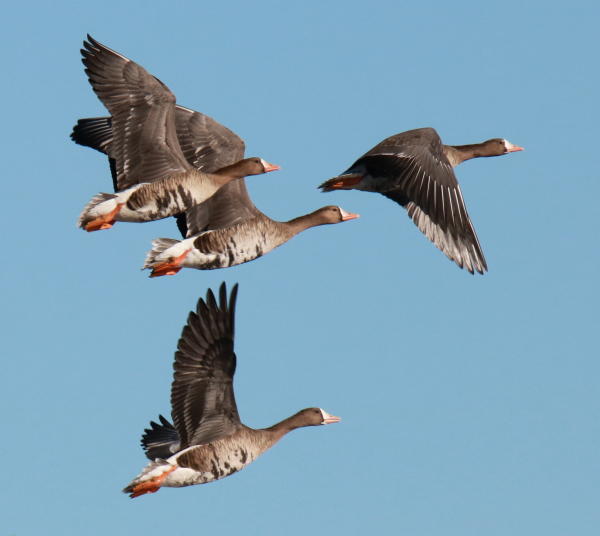
The action can be pretty fast and furious at times, forcing me to choose which flocks to focus on as they pass by. Sometimes it’s even a bit of a relief to catch my breath and take a look at the broader view around me, right. The sights and sounds of the geese from the Arctic charges me up in many ways, perhaps transferring some of that natural energy that we all crave from nature in the process.
It’s quite surprising that each spring and each fall when thousands of geese arrive in my neighborhood, I get just as excited year after year, decade after decade with the prospect of taking hundreds more photos of geese. You’d think I’d become satiated eventually, but for me, geese strike what seems to be an innate chord, and I can’t get enough. You may understand, but even if you don’t share my enthusiasm for migrating geese, they do offer great photo opportunities, and they provide exciting contacts with the great outdoors.
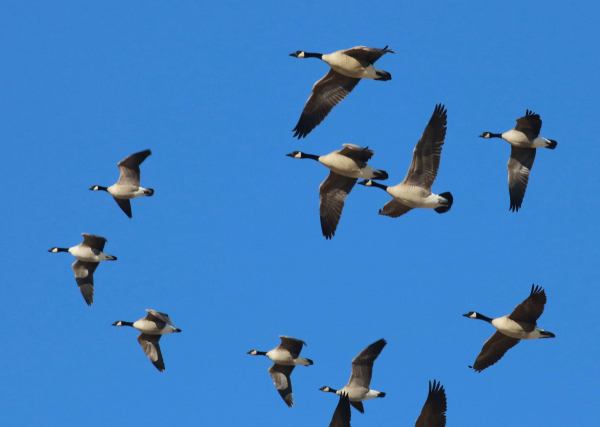
Article and photographs by Paul Konrad
Share your bird photos and birding experiences at editorstbw2@gmail.com